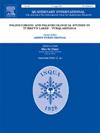印度岩浆中的微量元素变化:洞察全新世气候
IF 1.9
3区 地球科学
Q3 GEOGRAPHY, PHYSICAL
引用次数: 0
摘要
利用痕量元素(TE)比率(镁、钡、锶、铷、锰、钛、铀)对古普特斯瓦尔和卡达帕洞穴过去 7000 年的岩浆进行了调查,并通过 230Th/234U 测定法提供支持,以了解印度夏季季风引起的区域和地方气候多变性。方解石中 TE 的行为受温度、渗流路径、基岩化学和洞穴上方植被覆盖的影响。自公元前 7 ka 年以来,Ba/Sr 比值持续下降,这表明在此期间区域降水或当地水分供应发生了变化。然而,由于缺乏支持数据,确定滴水速率和化学成分的变化具有挑战性。TE 比率的变化表明,在 ∼4.2 ka BP 和 ∼2.8 ka BP,气候和沉积发生了显著变化。在 4.2 ka BP 到 3.8 ka BP 之间以及 2.8 ka BP ∼期间,降水量有所减少,而自 3.8 ka BP 以来,研究地点的风化沉积物因之前的干燥条件而有所增加。根据稳定同位素值推断出的潮湿和干燥气候阶段与微量元素比例的变化相吻合,从而肯定了所研究的微量元素在热带洞穴沉积中的古气候意义。研究地点在公元前 4.2 kaP 前后降水量下降的一个可能解释是热带辐合带(ITCZ)随着印度洋偶极子的负相南移。该地区普遍的干燥条件可能影响了向北的季风,导致印度河流域文明的衰落。在公元前 2.8 ka∼時所觀察到的另一個突變可能與低太陽活動、ITCZ 南移以及厄爾尼諾-南方濤動活動增強有關。本文章由计算机程序翻译,如有差异,请以英文原文为准。
Trace element variations in Indian speleothems: Insights into the Holocene climate
Speleothems from the Gupteswar and Kadapa caves were investigated using trace element (TE) ratios (Mg, Ba, Sr, Rb, Mn, Ti, U) over the last 7000 years, supported by 230Th/234U dating, to understand the regional and local climate variability induced by the Indian Summer Monsoon. The behavior of TE in calcite is influenced by temperature, seepage pathways, bedrock chemistry, and vegetation cover above the cave. A continuous decrease in the Ba/Sr ratio since 7 ka BP indicates changes in regional precipitation or local moisture availability during this period. However, determining changes in drip water rate and chemical composition is challenging due to the lack of supporting data. Variations in the TE ratios suggest significant climate and depositional changes at ∼4.2 ka BP and ∼2.8 ka BP. A decline in precipitation was observed between 4.2 and 3.8 ka BP and at ∼2.8 ka BP, with an increase in aeolian deposition at the study site since 3.8 ka BP because of preceding dry conditions. The moist and dry climate phases deduced from stable isotope values corroborate the variations in trace element ratios, affirming the paleoclimatic significance of the studied trace elements in tropical cave deposits. A probable explanation for the decline in precipitation at the study location around 4.2 ka BP is the southward migration of the Intertropical Convergence Zone (ITCZ) along with a negative phase of the Indian Ocean Dipole. The prevailing dry conditions in this region could have impacted the northward monsoonal winds, contributing to the decline of the Indus Valley Civilization. Another abrupt change observed at ∼2.8 ka BP can be linked to low solar activity and the southward movement of the ITCZ, coupled with enhanced El Niño-Southern Oscillation activity.
求助全文
通过发布文献求助,成功后即可免费获取论文全文。
去求助
来源期刊

Quaternary International
地学-地球科学综合
CiteScore
5.60
自引率
4.50%
发文量
336
审稿时长
3 months
期刊介绍:
Quaternary International is the official journal of the International Union for Quaternary Research. The objectives are to publish a high quality scientific journal under the auspices of the premier Quaternary association that reflects the interdisciplinary nature of INQUA and records recent advances in Quaternary science that appeal to a wide audience.
This series will encompass all the full spectrum of the physical and natural sciences that are commonly employed in solving Quaternary problems. The policy is to publish peer refereed collected research papers from symposia, workshops and meetings sponsored by INQUA. In addition, other organizations may request publication of their collected works pertaining to the Quaternary.
 求助内容:
求助内容: 应助结果提醒方式:
应助结果提醒方式:


